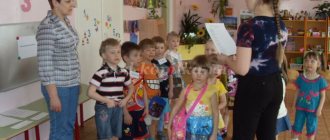Cool hours in 4th grade. Developments
Class hour in 4th grade on the topic “Guinness Show”
Objectives: to introduce students to the Guinness Book of Records;
develop observation and imagination in students; contribute to the creation of a positive emotional atmosphere in the classroom. Preparatory work: assign 2-4 students to the role of photojournalists (after the class hour, create a wall newspaper “Class Record Holders”).
Equipment: camera; props for competitions.
Class plan
I. Introductory conversation.
II. Information block “Guinness Book of Records”.
III. Competitions "Class record holders".
IV. Summarizing.
Class progress
I. Introductory conversation
Classroom teacher. Listen to the story and tell me what book they are talking about.
On Saturday 10 November 1951, Sir Hugh Beaver (1890-1967), brewery manager, was hunting with friends near the River Slany, County Wexford, south-east Ireland. But it was an unfortunate incident - the hunters shot unsuccessfully, and several golden plovers did not make it to the table. And in the evening, a heated debate broke out among a circle of friends gathered at the Castlebridge House estate: whether the golden plover was the fastest game bird in Europe. Unfortunately, there was no reference book at hand that could satisfy the curiosity of the gentlemen.
In August 1954, a dispute among hunters already familiar to us arose over a black grouse, which seemed to them to fly even faster. Sir Hugh Beaver thought that hundreds of similar questions were probably being discussed in the 81,400 pubs of England and Ireland and that there was no book to help settle the record disputes.
On September 12, 1954, Sir Hugh invited us, the brothers Norris and Ross McWherter, to an audience to see if our London news agency could help create the necessary reference book.
The publishing house was opened in London at 107 Fleet Street. And work on the first, 198-page edition began. The signal copy of the then unknown book was printed on August 27, 1955. (The story of the book told by its creator Norris McHuerter especially for Russian readers.)
II. Information block “Guinness Book of Records”
Classroom teacher. Already before the Christmas holidays, the Guinness Book of Records topped the bestseller list and never left it, with the exception of 1957 and 1959, when it was not reprinted. The first American edition was published in New York in 1965, followed by a French edition in 1962 and a German edition in 1963. In 1967 the book was published in Japanese, Spanish, Danish and Norwegian, and the following year in Swedish, Finnish and Italian. In the 1970s it was published from afar in Dutch, Portuguese, Czech, Hebrew, Serbo-Croatian, Icelandic and Slovenian.
In the 1980s translations of the Guinness Book of Records have been published in 13 languages: Greek, Indonesian, Chinese, Turkish, Malay, Arabic, Hungarian, Thai, Tamil, Telugu, Hindi, Malayalam. In February 1990, it was first published in Russian, and in December of the same year - in Polish. In 1991, Bulgarian, Romanian, Macedonian, and Korean editions of the book appeared.
Thus, the Guinness Book of Records was published in 43 languages. In November 1974, the book was named the most popular copyrighted book in publishing history. By that time, its total circulation had reached 23.9 million copies. And by mid-1993, more than 74 million copies of the Guinness Book of Records had been sold worldwide.
— Guys, why do you think this book has become so popular? (Students make guesses.)
— Do you know how to get into the Guinness Book of Records? (Children's answers.)
A record is considered to be something that surpasses already existing achievements, something that can be compared and contrasted with them. This is the main criterion for selecting information. Unique cases, curiosities, or something “the very first” are not always records, but they are of interest. Physical disability records are not included in the book. Also, records that pose an extreme danger to human life are not included in the book: long parachute jumps from low altitudes or excessive consumption of food.
According to the book's authors, in recent years efforts have been made to set duration records in many activities, such as the record for immobility. The duration of such marathons, which included prolonged insomnia, often reached extremes and threatened the lives of the aspirants. Therefore, before venturing into such a record, the authors ask to consult with the national editors of the Guinness Book of Records about its feasibility.
Some marathons allow 5-minute rest breaks, but only after every hour. These breaks are voluntary and can be cumulative. The accepted record is the total time, i.e. the time elapsed from start to finish, including breaks. The protocols must record the continuous observation of the attempt to establish a record, contain information about the chronological order, time of the event, duration and rest breaks. The documentation must be certified by the signatures of witnesses indicating the time of presence. The participation of at least two independent witnesses is desirable. Relatives of the contestant cannot be witnesses. Where possible, standings are maintained. Persons under 14 years of age are not allowed to participate. Individuals aged 14-18 must have written permission from a parent or guardian to participate.
Applicants must obtain confirmation of the record from a local or national newspaper and, if the competition is run by a national or international body, an official document confirming the results. Newspaper clippings must include the name of the newspaper, place of publication, and issue number in which the article appears. It is advisable that information about the event be broadcast on radio or television.
III. Competitions "Class Record Breakers"
Classroom teacher. Today we will try to identify our record holders in the class. First, you need to select an independent jury that will determine the winners in a particular competition.
(Invites several students to become members of the jury.)
Anyone can take part in the competition, but if someone wins one of the competitions, they will not be able to take part in the next one. Our correspondents will photograph everything that happens.
So let's begin.
IV. Summarizing
Classroom teacher. Let's applaud our winners! All memorable moments were captured, we look forward to the release of the wall newspaper “Class Records”.
Additional material
Competitions
1. Who will sit on a stool the longest, raising his legs above the floor and not holding onto anything with his hands.
2. Who will eat a piece of black bread faster and then whistle?
3. Who can do more squats while holding a pencil on their nose?
4. Who will pick up and hold the most balloons for 10 seconds?
5. Who can tie 5 knots on the fishing line faster?
6. Who can put an old newspaper into a bottle faster without tearing it?
7. Who can roll out the longest plasticine sausage in 1 minute?
8. Who drinks a glass of water through a straw faster?
9. Who can pronounce the sound I longer in one breath?
10. Who can stand on one leg longer in the “swallow” pose?
Examples of human achievements from the Guinness Book of Records
The biggest pancake
A pancake weighing 3 tons and with a diameter of 15.01 m was baked in Manchester (Great Britain) in August 1994 during the celebration of the 150th anniversary of the creation of the cooperative movement.
Apples cut by a sword in the air
May 30, 2004 Kenneth Lee cut 21 apples in the air with a samurai sword in 1 minute at the Tiger Style Karate Academy (New Jersey, USA).
Jumping rope
In July 2005, Isabel Bush (Alaska, USA) jumped rope 151,036 times in 24 hours. On average, she made 104 jumps per minute.
Applause
The record for the duration of clapping (58 hours 9 minutes) was set by V. Jeyaraman from Tamilnadu (India) from February 12 to 15, 1988. At the same time, the rate was at least 160 claps per minute and they could be heard at a distance of 109.7 m.
Strongmen
On October 19, 2005, at the Open International Heavyweight Championship in Norwood (USA), Briton Barry Andersen lifted a 63 kg weight with his little finger.
Lifting a piano up stairs
On December 5, 2001, Jose Angel Aria Villanueva (Spain) lifted first a stool and then a 175-kilogram piano onto a staircase with 15 steps 2.5 m high in 6.37 seconds, after which he played a three-minute etude on it.
Marathon: reading aloud (group)
From October 17 to October 21, 2005, four people—Linda Bagnall, Emily Churchman, Angela Forney, and Shirley Horn—read aloud at the Barney and Noble bookstore in Willington, North Carolina, USA, for 100 hours and 4 minutes.
Cool hours in 4th grade
Class hour. Tolerance 4th grade
Class hour 4th grade. Communication culture
Class hour 4th grade. Russia is my homeland
Extracurricular lesson on ecology, grades 3-4
Class hour. Tea party in 3-4th grade
Scenario of an extracurricular activity for grade 4 on the topic: My ancestry
Extracurricular activity in Russian language 4th grade
Class hour in 4th grade on the topic: Teach yourself to learn
Class hour in 4th grade on the topic: New Year
Class hour in 4th grade on the topic: Friendship
Class hour in 4th grade on the topic: Happy chance
Class hour in 4th grade. There is always room for heroism in life
Class hour in 4th grade on the topic: Traffic rules
Business game in 4th grade on the topic: Human Rights
Cool hour-conversation in 4th grade on the topic: Russian Navy
Class hour on the topic: Motherland
Game class hour on fairy tales for 4th grade
Development (notes) of a class hour in 4th grade
Kostidi Irina Konstantinovna
primary school teacher MBOU Prigorsk Secondary School,
highest qualification category;
Development of a classroom lesson in 4th grade
on the topic of:
«Live in peace with yourself and others"
Target:
acquaintance of students with the concept of “tolerance”, its origin, meaning and relevance of its formation as a moral quality of an individual.
Objectives:
Educational:
- Help students understand why it is important to respect others.
- Explain to students why it is very important to be able to solve problems peacefully.
Developmental:
- Develop speech and enrich students' vocabulary.
- Develop the ability to formulate and express your opinion, control yourself, and respect other people’s opinions.
Educational:
- To cultivate a positive attitude of students towards themselves, friends, classmates, the desire and ability to forgive.
Equipment:
handouts (trace cards), cards of different colors, magnetic board, multimedia equipment.
- Organizing time.
2. Introduction to the topic.
Teacher:
Today we will start our lesson with a Chinese parable that will help us formulate the topic of the lesson. The parable is called “Good Family”. Listen carefully.
(reading a parable)
Teacher:
what three words became law in a family where peace and harmony reigned?
Children: love, patience, forgiveness. Teacher:
what do you think we will talk about in class?
Children: friendship, kindness, patience, love, respect... Teacher:
everything that you just talked about and assumed can be combined and called in one word “tolerance.” Do you understand the meaning of this word?
3. Introducing a new concept.
Teacher:
tolerance - (lat. tolerantia - patience) is the ability to tolerate something or someone.
The concept of “tolerance” is unusual for ordinary Russian consciousness. Our Russian word is closer to us - “tolerance”. Tolerance is the ability and ability to endure, to be patient, to put up with other people’s opinions. It is quite difficult to define tolerance due to the fact that it is interpreted differently in different languages. And now we will be convinced of this. On your tables you have white cards on which the definitions of tolerance of different peoples of the world are given. Let’s read and answer the question: “What do the definitions have in common?” From white cards, children read:
- Tolerance is the ability to recognize ideas and opinions that differ from one’s own. (Spanish)
- Tolerance is the willingness to be tolerant and lenient. (English)
- Tolerance – allowing, accepting, being generous towards others. (Chinese)
- Tolerance – forgiveness, forbearance, gentleness, mercy, compassion, patience. (Arab)
Teacher:
What do these definitions have in common?
Children: the ability to live in peace and harmony with the whole world. Teacher:
recently it has become fashionable to talk about tolerance, the problem of tolerance is very relevant.
Why do you think? Children: there is an active increase in aggressiveness, conflicts, and crime. Teacher:
what does it mean to be tolerant?
Let's try to answer this question. You have yellow cards on your tables with statements written on them. Your task: read the statement, think and relate it to the corresponding commandment. Children read out the statements and relate them to the commandment.
4. Exercises to reinforce the concept of “tolerance”:
a) correlation of the statement with the commandment;
- “Our hearts should be filled with love for people, our brothers and sisters. We must think about them and help them without expecting the slightest reward." (love thy neighbour)
- “Anger is a passion in the disposition of the spirit, capable of frequent repetition, cruel and unyielding in strength, serving as the cause of murder, an ally of misfortune, an assistant of harm and dishonor.” (thou shalt not kill)
- “Don’t do to someone else what hurts you.” (Golden Rule)
- “Nothing pretended can last.” (do not lie)
- “Love for parents is the basis of all virtues.” (honor your father and your mother)
- Theft breeds laziness and greed. (don't steal)
Teacher:
So, to be tolerant means:
- Respect the other.
- Love your neighbor.
- Don't get angry.
- Be kind and tolerant.
- Compassionate.
Teacher:
I depicted “tolerance” in the form of a sun.
Why? Teacher:
the sun warms the whole world, so a tolerant person, doing good deeds, becomes better, cleaner, brighter. Goodness and warmth emanate from her. There are always friends around her, happiness reigns. A tolerant person understands others and always comes to their aid.
Physical education minute.
b) determination of the qualities of a tolerant person;
Teacher:
Now we will all together determine what character qualities a tolerant person possesses. Each of you has pink cards on your tables, on which the qualities of a person’s character are written. Select those that characterize a tolerant personality. And what, in your opinion, does not apply, cross it out. Qualities:
- Tolerance
- Heartlessness
- Conflict
- Compassion
- Forgiveness
- Hot temper
- Desire to do something together
- Mercy
- Gloat
- Lie
- Cooperation
- Respect for the rights of others
- Irritation
- Accepting others as they are
- Envy
Teacher:
So, a tolerant person has the following qualities...
c) solving problem situations.
Teacher:
think, do we all have the qualities of a tolerant person?
Children: no, we are quarreling... Teacher:
can we all calmly listen to each other? Support in difficult times? What causes conflicts between you and your friends, brothers or sisters? I present you with a situation. Show how the problem can be resolved peacefully.
- You are playing with a toy or a game and someone comes and takes it away without even asking whether you are finished playing or not.
- What will you do in this situation? — What can be done to maintain calm in a conflict situation? - How can you avoid a fight? Children: discuss the problem and go their separate ways, change the topic, postpone the discussion until both have calmed down.
Teacher:
I want to offer you a reminder that will teach you how to behave correctly in a conflict situation.
Memo.
- Stay calm when you're angry.
- Control yourself, have restraint and composure.
- Have the patience to listen to your interlocutor.
- Calmly explain your point of view.
- Think about what caused the dispute.
Another situation.
- You're playing a game and one of your team members doesn't follow the rules.
- What will you do in this situation?
5. General conversation.
Teacher:
Has it ever happened that someone spoke badly about you?
- How did you feel at that moment? -Have you ever spoken badly about anyone? - How do you think that person felt? — Guys, in such situations people get angry at each other, and sometimes there is a desire to fight. People should work together to solve problems that arise between them peacefully. Fighting is not the best way to solve problems. — It’s always very nice to hear when kind and good words are said about you. What is more pleasant for you to do – say kind words to people or say nasty things? —What instruction helps you live in peace? Children: Golden Rule: “Treat people the way you would like to be treated.
Teacher:
can we change ourselves for the better?
— A person should strive to change himself for the better, to live in peace with himself and others. — What helps us to be tolerant? Tolerant? Children: knowledge and observance of the commandments.
6. Result: “Bon voyage.”
Teacher:
Guys, you have cards made of colored cardboard in the form of a human footprint on your tables. Choose two qualities, two character traits that are your strengths. That is, two positive qualities that you possess. Write these qualities down on a trail card. We’ll hang them on the board under the heading “Bon voyage!”
My wishes:
- Guys, do to others the same way you want them to do to you.
- Be kind:
loving, attentive, patient, caring, merciful, forgive.
- Be Reliable:
honest, truthful, have a pure heart, keep your promises.
- Be caring:
polite, attentive, kind.
- Be generous:
not greedy, selfless, generous, ready to help.
- And all this will help you live in peace.



